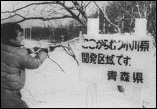|
|
 |
製作・構成:倉岡明子 Producer, Director : Kuraoka Akiko |
| 青森県下北半島。この半島の付け根にある六ヶ所村に、70年代初頭突然開発、工業化の話が持ち上がった。そして約10年後には巨大な石油コンビナートが建設されることになり、住人は土地を売り、立ち退いていった。しかしこの「陸の孤島」では今も残って暮らす人々がいる。厳しい自然環境のため作物も不作の日々が続き、人々の生活はいまだに自然との闘いである。農業や漁業に従事する老人たちの中には戦後入植してきた人も多い。ドル・ショック、オイル・ショックの影響で開発もいつの間にか縮小され反対運動も衰えたため、村は過疎化するばかりであった。しかし老人たちの満足げな笑みは自然と闘ってきた自信と経験に裏打ちされている。そして1984年、予測されたかのように六ヶ所村に核燃料サイクル基地立地が決定される。だが、静かに反対運動も始まっていた。かつて土本典昭の指導の下、六価クロムの公害を追求した『東京クロム砂漠』(1978)で知られる山邨=倉岡コンビは、倉岡の実家青森を拠点に2才の息子を連れ撮影を続けた。撮影は3年に及び息子は5才に成長する。この息子の存在が画面にも新鮮な効果をもたらしている。 | The Shimokita peninsula of Aomori prefecture. At the beginning of the 1970s, in the village of Rokkasho situated at the base of the Shimokita peninsula, the prospect of sudden development and industrialization was raised. 10 years later it was decided that a giant petrochemical complex would be built, so the local people sold their land and left. Yet even now people continue to live in this " island on the mainland; " they continue to battle the forces of nature in this inhospitable climate that always leaves them with an insufficient harvest. In actuality, many of the old people who continue to work in agriculture or the fishing industry only settled here after World War II. The occurrence of both the " dollar shock " and the " oil shock " abruptly cut back the national development plans, undermining the anti-development movement so that the population of the village continued to decline. But the old folk, backed by their experience of surviving till now in the struggle against natural forces, carried on with contented smiles. Then, in 1984, almost as if it had been planned from the beginning, it was decided that a nuclear reprocessing facility would be built at Rokkasho. In consequence, the opposition movement quietly began to reform. Recognized until now for working under Tsuchimoto Noriaki to make Tokyo Chrome Desert ( " Tokyo kuromu sabaku, " 1978), a film that investigated sexivalent chrome pollution, the Yamamura-Kuraoka team took their 2 year old son with them to film in Kuraoka's home prefecture of Aomori. Shooting stretched out over 3 years until their son reached the age of 5. The son's inclusion in the film lends it a fresh sensibility. |